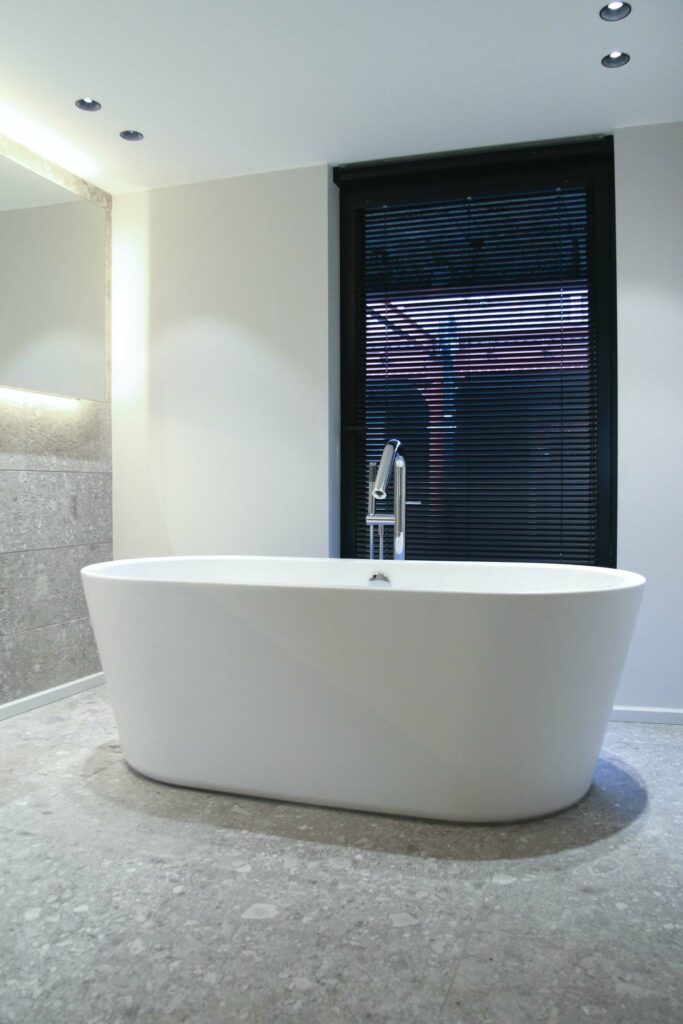Acrylic vs. Porcelain Tubs

Building a new home or remodeling a bathroom? One of the most important decisions you’ll need to make is the type of bathtub in your bathroom. This article compares the pros and cons of the different types of bathtub material to help you make the best decision for your project! Here’s everything you need to know about acrylic vs. porcelain tubs.
Table of Contents
- What Is an Acrylic Bathtub?
- What Is a Porcelain Bathtub?
- Acrylic vs. Porcelain Tub – Which Is Better?
- More Helpful New Build or Remodel Tips
What Is an Acrylic Bathtub?
Acrylic bathtubs are one of the most popular choices in current home builds and renovations and for good reason! This type of tub is low maintenance, durable, lightweight, and an affordable option. It also does a great job of retaining heat from hot water. This standard bathtub is one of the best types of soaking tubs there are!
But what exactly is an acrylic bathtub? Acrylic is a type of plastic. Acrylic tubs are made from vacuumed acrylic sheets and then reinforced with fiberglass. These types of tubs can be molded into almost any desired shape and can come in several color options.
How to Tell if a Bathtub Is Fiberglass or Acrylic
While acrylic tubs are finished with a fiberglass reinforcement, there are also fiberglass-based tubs. Fiberglass bathtubs are extremely lightweight and one of the most affordable bathtub options! While there are many pros and cons to both, here’s how to tell if a bathtub is fiberglass or acrylic:
- Fiberglass is more flexible, meaning the material would lightly press in if touched.
- Acrylic tends to be thinner than fiberglass. This can be seen around the edges of the bathtub!
- Fiberglass tends to be lighter in weight than acrylic.
- Fiberglass tubs are typically white, but acrylic tubs can come in various colors and textures.
Cleaning Acrylic Tubs
Less is more when it comes to cleaning an acrylic tub. Staying away from harsh and abrasive cleaners is key. It’s important to know the best materials and chemicals to help your bathtub last as long as possible! Here are some of the best items to use for daily cleaning of acrylic tubs and to prevent mildew:
- A soft sponge or soft brush
- Water + vinegar solution
- Better Life Natural Tub and Tile Cleaner
- Scum Off Shower Cleaner
When it comes to cleaning an acrylic tub, it’s best to get into a habit of cleaning once a week to maintain and lengthen the life of the tub!

What Is a Porcelain Bathtub?
A porcelain bathtub is made from formed steel, cast iron, glass, or tile that is then enameled with porcelain to create a solid surface. While a porcelain enamel tub tends to be more expensive and quite a bit heavier, it is also a much stronger, more durable option. If you’re looking for a tub that’s more scratch-resistant, easier to clean, and has lower maintenance overall, then a porcelain bathtub may be for you!
Rust Stains in Porcelain Tubs
While there are many great reasons to choose a porcelain tub for your home, one of the disadvantages is that they tend to develop rust stains over time. Here’s how to clean rust stains in porcelain bathtubs:
- Lemon + salt solution – squeeze lemon juice over the stains and add salt. Let sit for several hours, then lightly scrub clean and rinse with water!
- Baking soda – Mix baking soda with a little water to create a paste. Add the paste to the stains and let sit for a few hours. Scrub clean and rinse with water.
- Bar Keepers Friend
- Cream of tarter + hydrogen peroxide – mix to create a paste, then spread over the stain areas. After 10-15 minutes, scrub the area clean and rinse!
To prevent rust stains in porcelain bathtubs, it’s best to get into a habit of cleaning the tub once a week!

Acrylic vs. Porcelain Tub – Which Is Better?
The ultimate debate: acrylic vs. porcelain tubs. Which one is better? Well, the answer to this question really depends on your specific needs and circumstances. To help you decide which bathtub option is right for you, here’s a summary of the pros and cons of each type:
Acrylic Bathtub Pros
- Lightweight
- Durable
- Chip/crack resistant
- Retains heat well
- Can last 10-15 years
- Affordable/lower cost
- Easier to install
Acrylic Bathtub Cons
- Scratch easier
- Can stain or discolor
- Can’t use strong/harsh chemicals to clean
Porcelain Bathtub Pros
- Very sturdy/durable
- Scratch resistant
- Easier to clean
- Less prone to stains
- Can last 20-25 years
Porcelain Bathtub Cons
- Relatively poor heat retention
- Chip easier
- Limited colors/styles
- More expensive
- More difficult to install
Ultimately, you can’t go wrong with either option. When it comes to choosing acrylic vs. porcelain tubs, the decision depends on your plans for your new build home or bathroom remodel!






